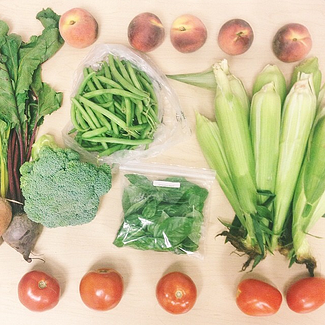September is Fruits and Veggies: More Matters Month, a national public initiative from the CDC and Produce for a Better Health Foundation to increase the consumption of fruits and vegetables. This national health issue is more widespread than most people realize; a 2005 CDC Survey found that less than a third of American adults reported eating at least two servings of fruit per day, and only 27% said they ate three or more servings of vegetables. With 2/3 of our population not meeting the recommended nutrition goals in their daily diets, we're happy to fully back this proposal. 
The reasons cited for not eating fruits and vegetables range from price to taste and everything in between. We've found that there are plenty of ways to combat those excuses and incorporate the right foods in your diet in a way you and your kids will actually enjoy. Here are our easy ways to eat more fruits and veggies every day:
1.) Try something new. It’s easy to get bored with bananas, overlook oranges or be passive towards potatoes. Mix it up with the more exotic offerings at the grocery store: try papayas, mangoes, kohlrabi or okra.
2.) Go for a dip. If you don't love the natural flavor of raw veggies, try them with a hummus or white bean spread, some spiced yogurt, or a tiny bit of salad dressing. Peanut or almond butter is also a favorite; use it on celery, bananas, or apples for a crunchy and fulfilling snack.
3.) Add them to foods you already like. Toss veggies into chili, stew, mac and cheese, pizza or omelettes. Pile them on sandwiches and burgers. Add fruit to oatmeal, yogurt, ice cream, pancakes or cottage cheese.
4.) Drink them up! Replace a drink or two a day with 100% vegetable or fruit juice, or replace your breakfast with a super-healthy and nutritious smoothie.
5.) Get them delivered. Look into a community-supported agriculture program, which delivers fresh, locally sourced fruits and vegetables straight to your door each week.
6.) Make a meal plan. One of the biggest reasons people turn to fast food is because they didn't have a plan. You know you're going to eat at least three times a day; why not make the most of those moments? Plan out your meals in advance to ensure you have a balance of fruits and veggies.
7.) Get inspired by Pinterest. Pinterest is a great resource for finding new and exciting recipes, or re-imaging fruits of vegetables in new ways. From baking eggs in avocado cups to a light dessert of chocolate-filled strawberries, we're sure you can find recipes you like that incorporate healthy ingredients.
8.) Know how to cook them and bring out the right flavors. Some vegetables are more bitter or strong-smelling, and often this can be exacerbated during cooking. Try one of these tricks to cut any bitter or overpowering flavor: add a little olive oil (or other fat) while stir-frying or sauteing; add something salty or sour (like a bit of soy sauce, balsamic vinegar, lemon, or shredded cheese); or glaze the vegetables with something sweet (honey or orange marmalade).
9.) Go all in. Have a all-vegetarian meal at least twice a week and challenge yourself to make new recipes.
10.) Make them easily accessible. Store your fruits in a bowl on the counter, veggies in pre-packaged containers/baggies, and/or dried fruit in your desk drawer for a quick snack. When you're hungry, it'll be easier to reach for these as a snack than buying a bag of chips from the vending machine.
With More Matters Month, we want to challenge ALL of you to fill half of your plate with fruits and veggies at every meal -- that's right, HALF! Whether it's morning, noon, or night, use this as a guideline to hit your nutritional goals every day. We're sure you'll notice a distinct difference in your body by the end of September!



